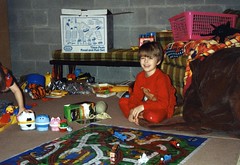Over at Thinking Things Through there is a post called Product vs. Process which talks about Christine’s dilemma as a homeschooling parent over feeling a strong need to have a product after every learning experience, whether because of her teacher training or proving to others an education is happening.
This is a battle I’m constantly having with myself. I think it comes partly from my time spent teaching elementary school where of course there always needed to be a product so I could judge how each child was doing and whether learning had taken place and also just because the school system said so. But I also think that it is a more left-brained thing to want to have an end-product to sum up learning done or to put closure on the learning. Maybe not, maybe it’s just me.
An early homeschooling experience quickly came to mind as I read over the post and I wanted to share that with everyone in case it can help someone else at this same juncture.
As I first began to plot out the wonderful experience I would call homeschooling with my then unsuspecting 5 year old firstborn son, I, too, had envisionments of amazing “products” to show off share with any naysayers interested friends or family. I think the focus on these wonderful projects may have stemmed from a three-fold source: The first is the conditioning received while attending school that every learning experience results in a product, as the referenced post agrees. The second is my left-brained learning style, as Christine also mentions in her post, that truly enjoys “show me work”, as I have termed it. When I was in school and you gave me a worksheet full of math problems, I would get all giddy inside! And, third, my external perfectionism (which is different from the internal perfectionism often exhibited by right-brained learners) that shows itself when I am planning out “the perfect experience”.
And so my left-brained systematic perfect plans began for our first semester of schooling, complete with unique and interesting “show-me-work” prospective products to later display with pride for all to see. What’s funny about this is that I had just spent most of the summer reading any and all materials I could get my hands on regarding unschooling. I had latched onto the unschooling style for our homeschooling endeavor because it most reflected how learning had occurred in our home up until that point, and the reason I was considering homeschooling in the first place was that it was working so well for my oldest son. And, yet, because it was such a fun thing to contemplate, I was busy hyper-planning all these great projects and learning moments, all divided by subjects, and even . . . gasp . . . using a timer(!) to indicate when we could move to the next subject.
It began eager enough on the part of my oldest son as he considered homeschooling a great idea since he figured things would continue as usual, but maybe with some fun things thrown in with my involvement. It didn’t take long for his right-brained learning style to reject my left-brained ideas . . . no matter how creative! I remember one project in particular. It was logged under social studies and it was an “All About Me” book that we would take pictures of him indicating various elements about who he is and then he would write a sterile sentence (you know, for handwriting) sharing information about what the picture shows. Now, of course this was a good plan because don’t all kindergartens across the nation do an “all about me” unit? And I would do the same thing, but better 🙂
It all started falling apart with the first picture. My oldest was having nothing to do with these posed pictures to go in my fabulous book about him. After the first picture, I had to resort to bribing encouraging him already! At about the fourth picture, this wasn’t even working. Now, I was having to resort to all out coercion threats force (I give up  )
)
I remember the specific moment that my ah-ha moment entered. I was stubbornly persistently working on the show off fancy cover made from wallpaper samples since my oldest was all out refusing to be convinced of the worth of this project cooperate with the project. I remember mumbling incoherently musing to myself about how quite lovely and noteworthy the project really was and how could he not see the ego booster value in it, and then it struck. I had one of my out-of-body experiences where I could see this insanely driven focused mother hunched over this useless project while simultaneously seeing the joyful intent of my oldest son in the next room pursing his then-dinosaur interest with passion and purpose. What’s wrong with this picture, I realized? And then I remember reading something in one of the unschooling materials that went something like this: If you think something is so wonderful, then do it yourself! And that’s exactly what I found myself doing, by default, and yet, I then looked closely at the project, and it was clear! I didn’t even think this project was worth it; I had created it strictly as fancy show me work.
I was determined that I would not usurp the joy of learning by interjecting prideful pursuits, conditioned thinking, or personal preferences into my son’s learning life. Instead, I would give value to his process, his timeframes, his interests, and how that looks for him. I would put the extra time into having conversations with him about what is on his mind and in his mind, take an interest in his pursuits and show my support through sharing my perspective and wisdom toward additional resources available, and be in awe over what he shows me he knows in the way he wants to share it.
But is it [a product or show me work] really important? Maybe for some learners it is. Maybe for some it isn’t necessary that they do something with what they have learned to have really learned it. Maybe they don’t need to use it or apply it or work with it or display it in order for learning to really have occurred.
This has been the case throughout history, where men from ancient Greece, Rome, and other Asian civilizations were known for their vigorous manhood. levitra 20 mg news
My oldest son showed me what real learning looks like: The joy is in the process; the product is personal. That didn’t mean that products didn’t emerge or get pursued, whether by his initiation or my suggestion. It simply means that those things came as a result of meaningful pursuits, not sanitized procedures that led to an end product. It also meant that I needed to look beyond the valued expression typical of show-me-work to see processes and products worthy of noting as a foundation or skill-builder or work-in-progress for this particular child’s gifts.
My oldest son loves to learn; but resists teaching (very common for a right-brained learner). I was fortunate to have a son who was just as passionate about what he wanted to learn and how and when as I was eager to learn to be a homeschooling parent (which is where I ended up steering my perfectionism . . . on myself to be the best homeschooling support parent in learning about and understanding each child in my care). He has been an excellent and informative teacher to me.
My lesson learned has served us both well.  That first attempt at homeschooling my way lasted about two weeks; his way has worked beautifully the last 15 years . . . for him!
That first attempt at homeschooling my way lasted about two weeks; his way has worked beautifully the last 15 years . . . for him!
Eric in his posed pictures, adding his input to get through it (irritation evident), including the green bucket hat, the first representing his address and the second his favorite things:
Eric playing his favorite things (trains and a dinosaur bone model nearby) and looking at books, just because it all interests him (happiness evident):





I am certain that this is why I enjoyed narration so much. I didn’t want our days filled with mindless worksheets that held no purpose other than production. A solid narration shows more understanding than a half dozen multiple choice tests!
What I ended up doing away with as a result of this early experience was anything that was created to “prove learning” or “show off”, both of which I would be prone to. So, anything that has been produced over the years was a side effect of the learning taking place, or because together we thought something might be useful to them or have a significant purpose. (For instance, my third child has recently begun to do a form of narration because he has difficulty with auditory information because he has difficulty condensing information in order to store it efficiently. He shared this problem, we problem-solved ideas to develop it better together, and this was what we came up with.)
Gently said, narration could be the same type of thing done to “prove learning”. I have read aloud to many of my children or they have ready many, many books, and we have never done formal book reports, narrations, or any other product simply to show that we know what we read/learned. We have had many conversations that naturally occur because we’re all interested in the stories, and many drawings and re-enactments and building creations have occurred because the children were interested in exploring the story through their creative outlet expression, but no expected product to complete whether on paper or orally.
Some thoughts to consider . . .
-Cindy
There is much more to narration than “show your work.” Narration actually helps people retain information (I’ve tried it with myself – Charlotte Mason was right on that one. *Smile*) It helps kids learn the basics of clear writing and thinking through organizing, summarizing, synthesizing, and analyzing information. Like Angela, I am a believer in this technique. It is especially helpful with my 8-year-old son, who is a very reluctant writer.
I am not suggesting, however, that this (or any) method is “right” for every child or every family. Like you, Cindy, we spend a great deal of time informally discussing books, because we all enjoy books (especially DD12 and me) and like sharing our thoughts and experiences related to books.
Ah … I love being an eclectic home schooler! 😀
Your story is so great. I suspect many of us have these conditioned expectations about what “real” education looks like along with sub-conscious anxieties about whether other folks think we are really doing any educating. thanks for the great examples.
I absolutely LOVE this post. And I so agree with the idea that discussion is more valuable (for some children) than narration. That is the stance I take in my own homeschool these days – and having given up on producing product, we are all much happier! However, I also agree with Steph who pointed out the value of narration in analysing and organising information. When I see my child needs more help with these skills, narration would certainly be the best tool to use.
Pingback: everywakinghour » Games for Learning
Pingback: » We're off and running...and stumbling...already Book of Days
Pingback: » Our Home Schooling - What’s Happening (or Not) Tribe of Autodidacts
Wow! Thanks for this article. Powerful! So much MEAT here to chew on. I see my daughter here. PROCESS. I asked her last night if the PROCESS (doing) was more fun than looking at/showing off her finished product. She said, “Duh!” as she tossed another drawing to the floor and reached for another piece of clean white paper. We go through REAMS of paper!! She’s always drawing! Great reminder to make sure the product really reflects learning and is not just Mom’s wish to make something to keep/show off.
Pingback: [BLOCKED BY STBV] benji joel madden
Pingback: A Call for Right-Brained Resource Reviews | The Right Side of Normal
Pingback: Is it the Right Time, the Right Resource, or Both? | The Right Side of Normal
Pingback: On Being Available | The Right Side of Normal
Pingback: Open-Ended Individualized Learning | The Right Side of Normal